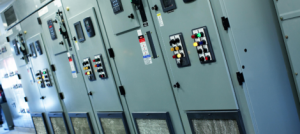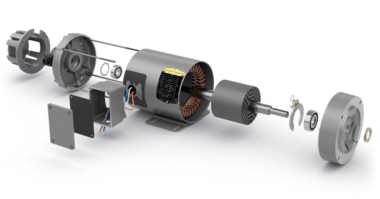As energy costs continue to increase, there is an increased demand for solutions that help pumps operate more reliably and cost effectively. By matching power consumption to dynamic system requirements, adjustable frequency drives (AFDs) are increasingly relied upon to provide steady, efficient power for variable speed applications. Further, drives protect valuable motor and pump assets by controlling power and minimizing trauma placed on the system by starting and stopping pumps.
Today’s adjustable frequency drives are result of and have benefited from years of evolution in motor starting technology that continues to generate more economic and flexible motor control. The first across-the-line starters applied full voltage to motor terminals and generated high inrush currents, which caused stress to mechanical equipment. Reduced-voltage starting evolved to manage inrush currents and peak voltages, and is required by some utilities to prevent excessive voltage drops in the supply grid. Solid-state soft starter technologies were later introduced to eliminate shock to mechanical equipment, as they reduce the load and torque applied to the motor powertrain during startup. Using SCR technology, soft starters provide a greater degree of control for reduced voltage starting to help avoid motor coupling and shaft damage, prevent rotor and winding failure, and stop drive belt squeal and breakage. Additionally, reduced voltage soft-starters offer a wide range of current limit settings, which provide greater control flexibility. For pumping processes, in particular, soft starters also help avoid “water hammer” in pipes, by reducing line pressure so valves can close gently and prevent a surge wave. Today, a wide range of motor starters offer high system configurability and flexibility for control gear design.
Recently, medium voltage adjustable frequency drives have become more prevalent in variable speed applications for a range of pumping applications. Adjustable frequency drives offer all the protective features of reduced voltage and soft starters, while variable speed control allows the process to match energy consumption with process demands. With a typical motor duty cycle in a variable speed pump or fan application, the resulting energy savings using a variable frequency drive in place of a traditional starter with mechanical speed control (valves, mechanical braking, etc.) can be significant. By matching power consumption directly with process requirements and maintaining optimal operating parameters at all times, the energy savings realized by using adjustable frequency drives can generate investment payback periods of less than two years.
Additionally, advances in MV adjustable frequency drive design and application have increased the long-term reliability and capital efficiency of medium voltage drives. Increases in semiconductor device ratings have allowed drive designs to produce comparable levels of output power with lower device counts. The emergence of fully-integrated drives has led to smaller equipment footprints and more efficient use of facility floor space. These two factors have driven additional increases in the long-term economic benefits of adjustable frequency drives beyond just energy savings.
Medium-Voltage Drives Achieve Dramatic Energy Savings
Today’s medium-voltage drives offer more efficient and reliable technologies in highly configurable and compact packages – reducing equipment footprint and energy and commissioning costs. The return on investment – in terms of energy and cost savings – on medium-voltage drives today can be calculated in terms of months. Consequently, medium-voltage drives are increasingly relied upon to meet energy efficiency demands.
For example, the West View Water Authority in the Pittsburgh area was using traditional motor starters to control two 2,000 horsepower (HP) pumps, which were transferring water from a reservoir to the treatment facility. This system had to run continuously – regardless of actual system demand. With the conventional motor starters, the pumps were continuously operating at full speed, causing significant mechanical stress, frequent water main breaks and significant maintenance expense. Because the motors were being started across the line, the massive inrush of current was causing high stress on the system and generating enough heat to prematurely age the rotors. Beyond that, the utility was charging for the peak demand, the 1,400 amp draw when the motors were started, which resulted in costly energy bills.
To reduce wear and tear on motor and pump assets and generate considerable energy savings, the West View team turned to the Eaton Ampgard® SC 9000 adjustable frequency drives. The compact design of the Ampgard SC 9000 enabled seamless integration of two, 2,000 HP adjustable frequency drives within the existing control lineup with minimal demolition and installation costs.
Eaton helped to install the drives while limiting downtime, so that the facility could continue to meet its demand and pump water to its customers – without interruption.
With Eaton’s adjustable frequency drive solution, the West View water treatment plant achieved significant efficiencies and savings. The transfer pumps are now run continuously at optimal speeds, using only the power that is needed. Furthermore, the drives are protecting key process equipment by reducing the wear and tear on system pumps and motors – so, there are less main breaks due to trauma on the system.
Now, the motors are using less than 200 amps with the Ampgard SC 9000 drives, whereas they previously they used 1,400 amps when they started across the line. All in all, this means that the Eaton adjustable frequency drives are yielding over $30,000 per month in energy savings for the facility.
Today’s drives can save industrial customers up to 40% in annual energy consumption in typical medium voltage applications. With the rising cost of energy, industrial customers can calculate the return on investment in medium voltage drive in terms of months, not years. Learn more about how adjustable frequency drives can generate substantial energy efficiencies and savings at www.eaton.com/SC9000.
Author Information:
Harry Broussard is a marketing manager at Eaton Corporation. His experience in adjustable frequency drives spans low and medium voltage drives conceptual development, extensive applications experience and field sales management.
Paul S. Twaddell is the industry segment manager for pumps and compressors at Eaton Corporation. He has a Masters of Business Administration and Engineering Management from Northwestern University’s Kellogg School of Management and McCormick School of Engineering.




